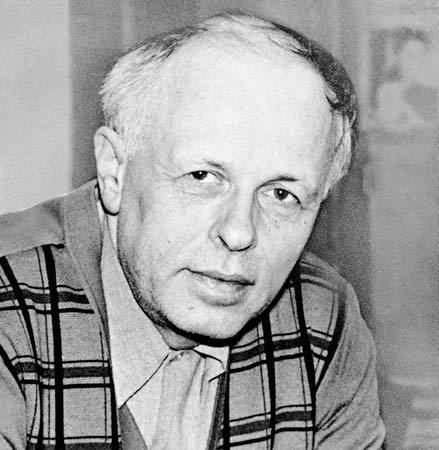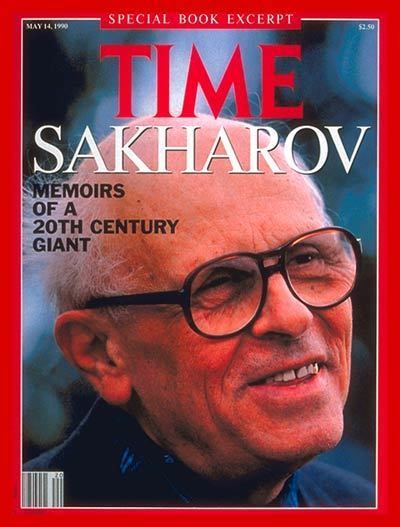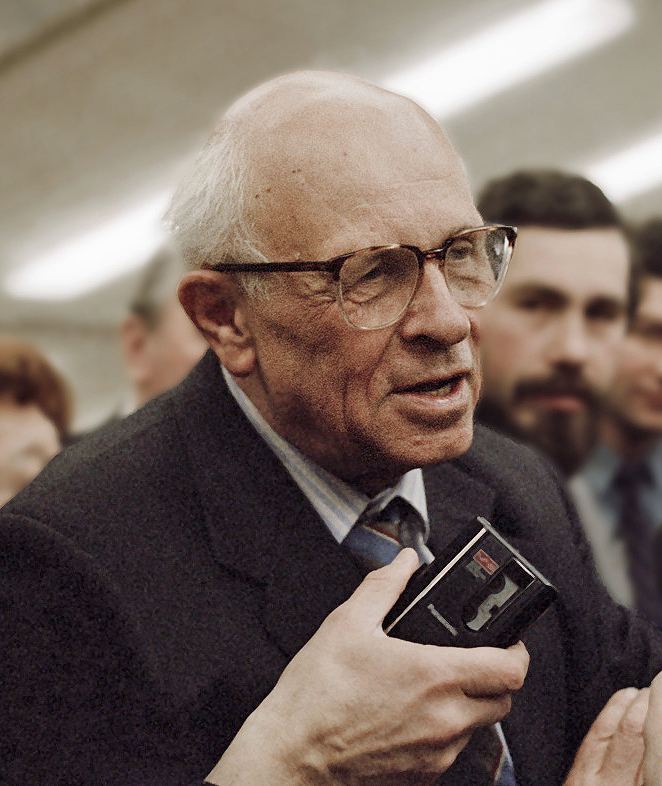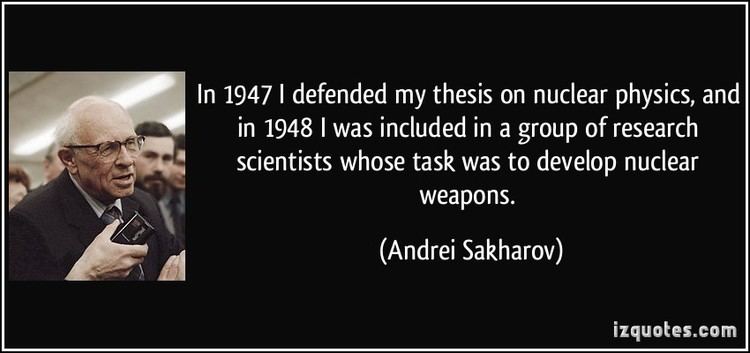Name Andrei Sakharov Role Nuclear Physicist | ||
 | ||
Native name Андрей Дмитриевич Сахаров Born May 21, 1921Moscow, Russian SFSR ( 1921-05-21 ) Alma mater Moscow State UniversityFIAN Known for Third IdeaSoviet nuclear programTokamakDissidenceHuman rights activismSakharov conditions Died December 14, 1989, Moscow, Russia Books Sakharov speaks, My country and the world Parents Ekaterina Alekseevna, Dmitri Ivanovich Sakharov Similar People | ||
Andrei sakharov quotes
Andrei Dmitrievich Sakharov (Russian: Андре́й Дми́триевич Са́харов; 21 May 1921 – 14 December 1989) was a Russian nuclear physicist, dissident, and activist for disarmament, peace and human rights.
Contents
- Andrei sakharov quotes
- Andrei Sakharov
- Biography
- Education and career
- Development of thermonuclear devices
- Support for peaceful use of nuclear technology
- Magneto implosive generators
- Particle physics and cosmology
- Turn to activism
- Attacked by Soviet establishment 1972 onwards
- Nobel Peace Prize 1975
- Internal exile 19801986
- Political leader
- Death
- Memorial prizes
- Andrei Sakharov Archives and Human Rights Center
- Places
- Media
- Honours and awards
- References

He became renowned as the designer of the Soviet Union's RDS-37, a codename for Soviet development of thermonuclear weapons. Sakharov later became an advocate of civil liberties and civil reforms in the Soviet Union, for which he faced state persecution; these efforts earned him the Nobel Peace Prize in 1975. The Sakharov Prize, which is awarded annually by the European Parliament for people and organizations dedicated to human rights and freedoms, is named in his honor.

Andrei Sakharov
Biography

Sakharov was born in Moscow on May 21, 1921. His father was Dmitri Ivanovich Sakharov, a private school physics teacher and an amateur pianist. His father later taught at the Second Moscow State University. Andrei's grandfather Ivan had been a prominent lawyer in the Russian Empire who had displayed respect for social awareness and humanitarian principles (including advocating the abolition of capital punishment) that would later influence his grandson. Sakharov's mother was Yekaterina Alekseyevna Sakharova, a great-granddaughter of the prominent military commander Alexey Semenovich Sofiano (who was of Greek ancestry). Sakharov's parents and paternal grandmother, Maria Petrovna, largely shaped his personality. His mother and grandmother were churchgoers; his father was a nonbeliever. When Andrei was about thirteen, he realized that he did not believe, but in later life he unequivocally described his religious feeling.
Education and career

Sakharov entered Moscow State University in 1938. Following evacuation in 1941 during the Great Patriotic War (World War II), he graduated in Aşgabat, in today's Turkmenistan. He was then assigned to laboratory work in Ulyanovsk. In 1943, he married Klavdia Alekseyevna Vikhireva, with whom he raised two daughters and a son before she died in 1969. He returned to Moscow in 1945 to study at the Theoretical Department of FIAN (the Physical Institute of the Soviet Academy of Sciences). He received his Ph.D. in 1947.
Development of thermonuclear devices

After World War II, he researched cosmic rays. In mid-1948 he participated in the Soviet atomic bomb project under Igor Kurchatov and Igor Tamm. Sakharov's study group at FIAN in 1948 came up with a second concept in August–September 1948. Adding a shell of natural, unenriched uranium around the deuterium would increase the deuterium concentration at the uranium-deuterium boundary and the overall yield of the device, because the natural uranium would capture neutrons and itself fission as part of the thermonuclear reaction. This idea of a layered fission-fusion-fission bomb led Sakharov to call it the sloika, or layered cake. The first Soviet atomic device was tested on August 29, 1949. After moving to Sarov in 1950, Sakharov played a key role in the development of the first megaton-range Soviet hydrogen bomb using a design known as Sakharov's Third Idea in Russia and the Teller-Ulam design in the United States. Before his Third Idea, Sakharov tried a "layer cake" of alternating layers of fission and fusion fuel. The results were disappointing, yielding no more than a typical fission bomb. However the design was seen to be worth pursuing because deuterium is abundant and uranium is scarce, and he had no idea how powerful the US design was. One of the Bikini atomic experiments changed that, because the magnitude of the explosion became public knowledge when there was a dispute between Japan and the US over the contamination of a large area of ocean. Sakharov was surprised by the size of the explosion and realized that the Americans had harnessed the power of a separate fission explosion to compress the fusion fuel. Sakharov realised that in order to cause the explosion of one side of the fuel to symmetrically compress the fusion fuel, a mirror could be used to reflect the radiation. The details had not been officially declassified in Russia when Sakharov was writing his memoirs, but in the Teller-Ulam design, soft X-rays emitted by the fission bomb were focused onto a cylinder of lithium deuteride to compress it symmetrically. This is called radiation implosion. The Teller-Ulam design also had a secondary fission device inside the fusion cylinder to assist with the compression of the fusion fuel and generate neutrons to convert some of the lithium to tritium, producing a mixture of deuterium and tritium. Sakharov's idea was first tested as RDS-37 in 1955. A larger variation of the same design which Sakharov worked on was the 50 Mt Tsar Bomba of October 1961, which was the most powerful nuclear device ever detonated.

Sakharov saw "striking parallels" between his fate and those of J. Robert Oppenheimer and Edward Teller in the USA. Sakharov believed that in this "tragic confrontation of two outstanding people", both deserved respect, because "each of them was certain he had right on his side and was morally obligated to go to the end in the name of truth." While Sakharov strongly disagreed with Teller over nuclear testing in the atmosphere and the Strategic Defense Initiative, he believed that American academics had been unfair to Teller's resolve to get the H-bomb for the United States since "all steps by the Americans of a temporary or permanent rejection of developing thermonuclear weapons would have been seen either as a clever feint, or as the manifestation of stupidity. In both cases, the reaction would have been the same – avoid the trap and immediately take advantage of the enemy's stupidity."

Sakharov never felt that by creating nuclear weapons he had "known sin", in Oppenheimer's expression. He later wrote: "After more than forty years, we have had no third world war, and the balance of nuclear terror ... may have helped to prevent one. But I am not at all sure of this; back then, in those long-gone years, the question didn't even arise. What most troubles me now is the instability of the balance, the extreme peril of the current situation, the appalling waste of the arms race ... Each of us has a responsibility to think about this in global terms, with tolerance, trust, and candor, free from ideological dogmatism, parochial interests, or national egotism."
Support for peaceful use of nuclear technology
In 1950 he proposed an idea for a controlled nuclear fusion reactor, the tokamak, which is still the basis for the majority of work in the area. Sakharov, in association with Igor Tamm, proposed confining extremely hot ionized plasma by torus shaped magnetic fields for controlling thermonuclear fusion that led to the development of the tokamak device.
Magneto-implosive generators
In 1951 he invented and tested the first explosively pumped flux compression generators, compressing magnetic fields by explosives. He called these devices MK (for MagnetoKumulative) generators. The radial MK-1 produced a pulsed magnetic field of 25 megagauss (2500 teslas). The resulting helical MK-2 generated 1000 million amperes in 1953.
Sakharov then tested a MK-driven "plasma cannon" where a small aluminum ring was vaporized by huge eddy currents into a stable, self-confined toroidal plasmoid and was accelerated to 100 km/s. Sakharov later suggested replacing the copper coil in MK generators with a large superconductor solenoid to magnetically compress and focus underground nuclear explosions into a shaped charge effect. He theorized this could focus 1023 protons per second on a 1 mm2 surface.
Particle physics and cosmology
After 1965 Sakharov returned to fundamental science and began working on particle physics and physical cosmology.
He mainly tried to explain the baryon asymmetry of the universe, considering for the first time CPT-symmetric events occurring before the Big Bang:
Sakharov was the first scientist to introduce twin universes he called "sheets". He achieved a complete CPT symmetry since the second sheet is populated by invisible "shadow matter" which is antimatter (C-symmetry) because of an opposite CP-violation there, and the two sheets are mirror of each other both in space (P-symmetry) and time (T-symmetry) through the same initial gravitational singularity.
In his first model the two universes did not interact, except via local matter accumulation whose density and pressure become high enough to connect the two sheets through a bridge without spacetime between them, but with a continuity of geodesics beyond the Schwarzschild radius with no singularity, allowing an exchange of matter between the two conjugated sheets, based on an idea after Igor Dmitriyevich Novikov. Novikov called such singularities a collapse and an anticollapse, which are an alternative to the couple black hole and white hole in the wormhole model. Sakharov also proposed the idea of induced gravity as an alternative theory of quantum gravity.
Turn to activism
Since the late 1950s Sakharov had become concerned about the moral and political implications of his work. Politically active during the 1960s, Sakharov was against nuclear proliferation. Pushing for the end of atmospheric tests, he played a role in the 1963 Partial Test Ban Treaty, signed in Moscow.
Sakharov was also involved in an event with political consequences in 1964, when the USSR Academy of Sciences nominated for full membership Nikolai Nuzhdin, a follower of Trofim Lysenko (initiator of the Stalin-supported anti-genetics campaign Lysenkoism). Contrary to normal practice Sakharov, a member of the Academy, publicly spoke out against full membership for Nuzhdin, holding him responsible for "the defamation, firing, arrest, even death, of many genuine scientists." In the end, Nuzhdin was not elected, but the episode prompted Sergei Khrushchev to order the KGB to gather compromising material on Sakharov.
The major turn in Sakharov's political evolution came in 1967, when anti-ballistic missile defense became a key issue in US–Soviet relations. In a secret detailed letter to the Soviet leadership of July 21, 1967, Sakharov explained the need to "take the Americans at their word" and accept their proposal for a "bilateral rejection by the USA and the Soviet Union of the development of antiballistic missile defense", because otherwise an arms race in this new technology would increase the likelihood of nuclear war. He also asked permission to publish his manuscript (which accompanied the letter) in a newspaper to explain the dangers posed by this kind of defense. The government ignored his letter and refused to let him initiate a public discussion of ABMs in the Soviet press.
In May 1968 Sakharov completed an essay entitled "Reflections on Progress, Peaceful Coexistence, and Intellectual Freedom". In it, he described the anti-ballistic missile defense as a major threat of world nuclear war. After this essay was circulated in samizdat and then published outside the Soviet Union, Sakharov was banned from conducting any military-related research and returned to FIAN to study fundamental theoretical physics.
Over the next twelve years, until his exile to Gorky (Nizhny Novgorod) in January 1980, Andrei Sakharov assumed the role of a widely recognized and open dissident in Moscow. He stood vigil outside closed courtrooms, wrote appeals on behalf of more than two hundred individual prisoners, and continued to write essays about the need for democratization.
In 1970 Sakharov was among the three founding members of the Committee on Human Rights in the USSR along with Valery Chalidze and Andrei Tverdokhlebov. The Committee wrote appeals, collected signatures for petitions and succeeded in affiliating with several international human rights organizations. Its work was the subject of many KGB reports and brought Sakharov under increasing pressure from the government.
Sakharvov married a fellow human rights activist, Yelena Bonner, in 1972.
By 1973 Sakharov was meeting regularly with Western correspondents, holding press conferences in his apartment. He appealed to the U.S. Congress to approve the 1974 Jackson-Vanik Amendment to a trade bill, which coupled trade tariffs to the Kremlin's willingness to allow freer emigration.
Attacked by Soviet establishment, 1972 onwards
In 1972 Sakharov became the target of sustained pressure and intimidation, from his fellow scientists in the USSR Academy of Sciences, the Soviet press and direct threats of physical assault. Dissident activists, including the writer Solzhenitsyn, sprang to his defence.
In 1973 and 1974, the Soviet media campaign continued, targeting both Sakharov and Aleksandr Solzhenitsyn. While Sakharov disagreed with Solzhenitsyn's vision of Russian revival, he deeply respected him for his courage. Only a few individuals in the Soviet Union were willing to defend 'traitors' like Sakharov and Solzhenitsyn, and those who had dared were inevitably punished.
Sakharov later described that it took "years" for him to "understand how much substitution, deceit, and lack of correspondence with reality there was" in the Soviet ideals. "At first I thought, despite everything that I saw with my own eyes, that the Soviet State was a breakthrough into the future, a kind of prototype for all countries". Then he came, in his words, to "the theory of symmetry: all governments and regimes to a first approximation are bad, all peoples are oppressed, and all are threatened by common dangers."
After that he realized that there is not much "symmetry between a cancer cell and a normal one. Yet our state is similar to a cancer cell – with its messianism and expansionism, its totalitarian suppression of dissent, the authoritarian structure of power, with a total absence of public control in the most important decisions in domestic and foreign policy, a closed society that does not inform its citizens of anything substantial, closed to the outside world, without freedom of travel or the exchange of information." Sakharov's ideas on social development led him to put forward the principle of human rights as a new basis of all politics. In his works he declared that "the principle 'what is not prohibited is allowed' should be understood literally", defying the unwritten ideological rules imposed by the Communist ruling elite on the society in spite of the seemingly democratic (1936) USSR Constitution.
In no way did Sakharov consider himself a prophet or the like: "I am no volunteer priest of the idea, but simply a man with an unusual fate. I am against all kinds of self-immolation (for myself and for others, including the people closest to me)." In a letter written from exile, he cheered up a fellow physicist and human rights activist with the words: "Fortunately, the future is unpredictable and also – because of quantum effects – uncertain." For Sakharov the indeterminacy of the future supported his belief that he could, and should, take personal responsibility for it.
Nobel Peace Prize (1975)
In 1973, Sakharov was nominated for the Nobel Peace Prize and in 1974 was awarded the Prix mondial Cino Del Duca.
Sakharov was awarded the Nobel Peace Prize in 1975. The Norwegian Nobel Committee called him "a spokesman for the conscience of mankind". In the words of the Nobel Committee's citation: "In a convincing manner Sakharov has emphasised that Man's inviolable rights provide the only safe foundation for genuine and enduring international cooperation."
Sakharov was not allowed to leave the Soviet Union to collect the prize. His wife Yelena Bonner read his speech at the ceremony in Oslo, Norway. On the day the prize was awarded, Sakharov was in Vilnius, where human rights activist Sergei Kovalev was being tried. In his Nobel lecture, titled "Peace, Progress, Human Rights", Sakharov called for an end to the arms race, greater respect for the environment, international cooperation, and universal respect for human rights. He included a list of prisoners of conscience and political prisoners in the USSR, stating that he shares the prize with them.
By 1976 the head of the KGB Yuri Andropov was prepared to call Sakharov "Domestic Enemy Number One" before a group of KGB officers.
Internal exile (1980–1986)
Sakharov was arrested on January 22, 1980, following his public protests against the Soviet intervention in Afghanistan in 1979, and was sent to internal exile in the city of Gorky, now Nizhny Novgorod, a city that was off limits to foreigners.
Between 1980 and 1986, Sakharov was kept under tight Soviet police surveillance. In his memoirs he mentions that their apartment in Gorky was repeatedly subjected to searches and heists. Sakharov was named the 1980 Humanist of the Year by the American Humanist Association.
In May 1984, Sakharov's wife, Yelena Bonner, was detained and Sakharov began a hunger strike, demanding permission for his wife to travel to the United States for heart surgery. He was forcibly hospitalized and force-fed. He was held in isolation for four months. In August 1984 Yelena Bonner was sentenced by a court to five years of exile in Gorky.
In April 1985, Sakharov started a new hunger strike for his wife to travel abroad for medical treatment. He again was taken to a hospital and force-fed. In August the Politburo discussed what to do about Sakharov. He remained in the hospital until October 1985 when his wife was allowed to travel to the United States. She had heart surgery in the United States and returned to Gorky in June 1986.
In December 1985, the European Parliament established the Sakharov Prize for Freedom of Thought, to be given annually for outstanding contributions to human rights.
On December 19, 1986, Mikhail Gorbachev, who had initiated the policies of perestroika and glasnost, called Sakharov to tell him that he and his wife could return to Moscow.
Political leader
In 1988, Sakharov was given the International Humanist Award by the International Humanist and Ethical Union. He helped to initiate the first independent legal political organizations and became prominent in the Soviet Union's growing political opposition. In March 1989, Sakharov was elected to the new parliament, the All-Union Congress of People's Deputies and co-led the democratic opposition, the Inter-Regional Deputies Group. In November the head of the KGB reported to Mikhail Gorbachev on Sakharov's encouragement and support for the coal-miners' strike in Vorkuta.
Death
Soon after 21:00 on December 14, 1989, Sakharov went to his study to take a nap before preparing an important speech he was to deliver the next day in the Congress. His wife went to wake him at 23:00 as he had requested but she found Sakharov dead on the floor. According to the notes of Yakov Rapoport, a senior pathologist present at the autopsy, it is most likely that Sakharov died of an arrhythmia consequent to dilated cardiomyopathy at the age of 68. He was interred in the Vostryakovskoye Cemetery in Moscow.
Memorial prizes
The Sakharov Prize for Freedom of Thought was established in 1988 by the European Parliament in his honour, and is the highest tribute to human rights endeavours awarded by the European Union. It is awarded annually by the parliament to "those who carry the spirit of Soviet dissident Andrei Sakharov"; to "Laureates who, like Sakharov, dedicate their lives to peaceful struggle for human rights."
An Andrei Sakharov prize has also been awarded by the American Physical Society every second year since 2006 "to recognize outstanding leadership and/or achievements of scientists in upholding human rights".
The Andrei Sakharov Prize For Writer's Civic Courage was established in October 1990.
In 2004, with the approval of Elena Bonner, an annual Sakharov Prize for journalism was established for reporters and commentators in Russia. Funded by former Soviet dissident Pyotr Vins, now a businessman in the USA, the prize is administered by the Glasnost Defence Foundation in Moscow. The prize "for journalism as an act of conscience" has been won over the years by famous journalists such as Anna Politkovskaya and young reporters and editors working far from Russia's media capital, Moscow. The 2015 winner was Yelena Kostyuchenko.
Andrei Sakharov Archives and Human Rights Center
The Andrei Sakharov Archives and Human Rights Center, established at Brandeis University in 1993, are now housed at Harvard University. The documents from that archive were published by the Yale University Press in 2005. These documents are available online. Most of documents of the archive are letters from the head of the KGB to the Central Committee about activities of Soviet dissidents and recommendations about the interpretation in newspapers. The letters cover the period from 1968 to 1991 (Brezhnev stagnation). The documents characterize not only Sakharov's activity, but that of other dissidents, as well as that of highest-position apparatchiks and the KGB. No Russian equivalent of the KGB archive is available.
Places
Media
Honours and awards
In 1980, Sakharov was stripped of all Soviet awards for "anti-Soviet activities". Later, during glasnost, he declined the return of his awards and, consequently, Mikhail Gorbachev did not sign the necessary decree.
